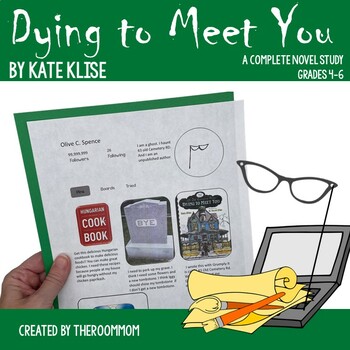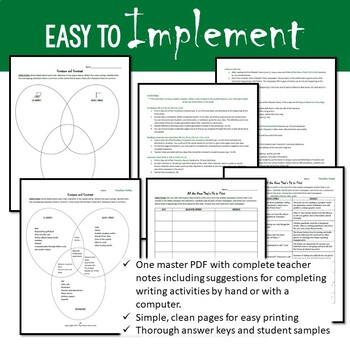Dying to Meet You 43 Old Cemetery Road Novel Study Unit
- Zip
Description
Dying to Meet You by Kate Klise is a unique novel study unit that is a big hit with students. This standards based 43 Old Cemetery Road literature guide offers lots of practice with inference skills. The students must read "between the lines" in the letters that the characters write back and forth to each other to understand the story plot and characters.
There are several creative writing activities from which to choose as well as vocabulary lists, story plot maps, and character charts included in the materials. The "Fakebook" page, character Pinterest board, and character report card activities could be adapted for any novel study.
Literature Resource Includes:
Common Core Standards (4th grade)
Discussion Topics
Vocabulary Lists
Reading Comprehension Questions
Character Chart
Compare/Contrast Main Characters Venn Diagram
Alliteration
Inference using the newspaper articles
Story Plot Map
Analyze Character Traits
Design a Personal Letterhead
Letter Writing Activity
Epistolary Novel Activity (combine letters into a book that tell a story)
Fakebook Page Activity (design a Facebook-like page from the point of view of one of the main characters)
Character Report Card Writing Activity
Study Guide
Final Test
Write to the Author Information
BONUS Book Character Pinterest Board creative writing activity with printable template to complete by hand or separate PowerPoint template to complete on computers
Students love the creative formats for the writing activity choices. The writing projects require lots of critical thinking about the characters, but students get to showcase their knowledge in unique formats. It's a great way to get students excited to share what they know about the characters.
If you choose to create the classroom epistolary novel, it provides a great extension for a letter writing project. We use it to connect our "big" and "little" program in our school, but you could write to former teachers, families, or organize a letter exchange with students at another school.
** Answer keys, teacher notes, and student samples included for all activity pages and handouts **
⭐️⭐️⭐️⭐️⭐️Claudia D. said, "I used this as an introduction to epistolary writing. We had a great time with this and our own stories. A rare find."
Interested in a free activity for writing to any book author? CLICK HERE
Want another book in a journal format? Try LOVE THAT DOG or HATE THAT CAT and incorporate some poetry lessons too!
This product is a zipped file. The literature guide with the student pages and teacher notes is a secure PDF file and is not editable. There is a separate PowerPoint file with a semi-editable template to create the Character Pinterest Board electronically.
Copyright © TheRoomMom.
Permission to copy for single classroom use only.
Please purchase additional licenses if you intend to share this product.





